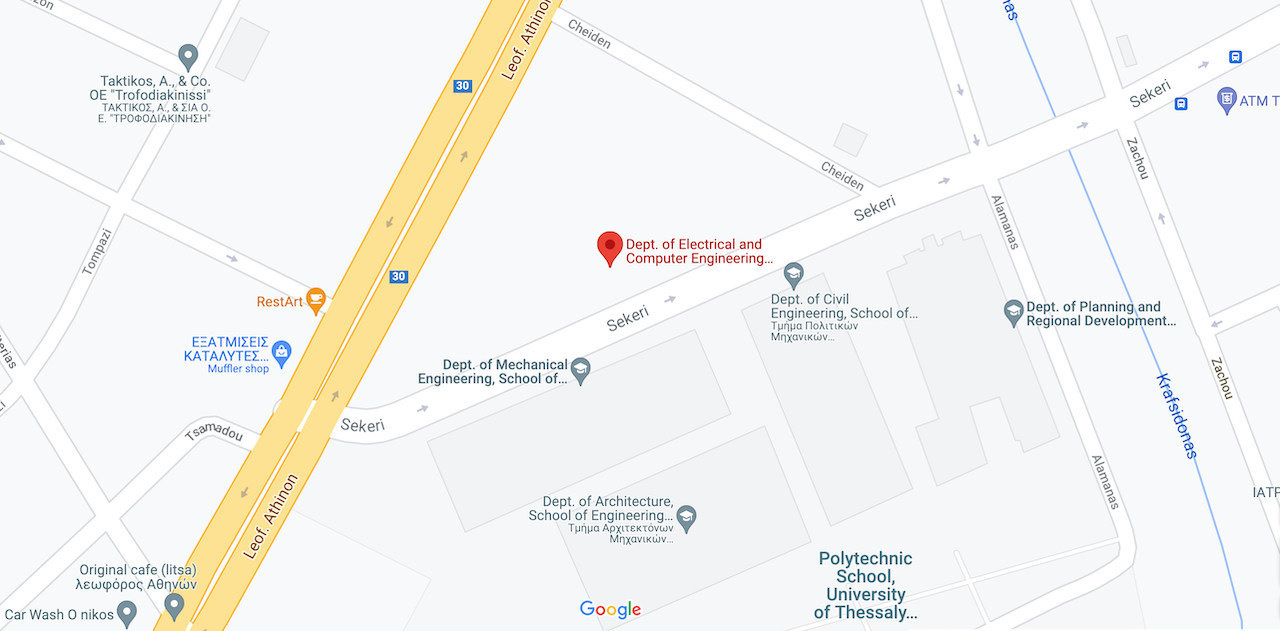| Subject Area | Energy |
|---|---|
| Semester | Semester 6 – Spring |
| Type | Elective |
| Teaching Hours | 4 |
| ECTS | 6 |
| Course Site | https://eclass.uth.gr/courses/E-CE_U_327/ |
| Course Director |
|
| Course Instructor |
|
- Atomic and molecular structure: atomic parameters, Bohr’s atomic model, Pauli’s exclusion principle, distribution of electrons in layers and sublayers, quantum numbers, valence electrons, periodic table of chemical elements.
- Kinds of bonds between atoms in solids: ionic parameters, energy and cohesion forces, covalent-, ionic-, metallic-, secondary-and mixed bonds, effect of the kind of bond on the physical properties of solids.
- Thermally activated processes: average kinetic energy and temperature, thermal expansion, internal stresses, deformation and Young’s coefficient, elastic and plastic deformation, thermal oscillations and electric noise, Arrhenius equation, atomic diffusion and coefficient of diffusion.
- Crystallographic state of solids: Elements of crystallography, crystallographic systems, types of crystal lattices, crystallographic directions and crystallographic planes, allotropy and polymorphism, crystal defects and their effects on the mechanical and electrical properties of solids, development of monocrystals for the manufacture of integrated circuits by using the Czochralski’s method, phase diagrams for two-phases fusible- and Pb-Sn alloys.
- Electrical and Thermal Conductivity of Solids: Drude’s theory for electrical conductivity, metal’s resistivity and its dependence upon temperature, Matthiessen’s- and Nordheim’s rules for resistivity estimation of metals and alloys, Hall effect, electrical conductivity in semiconductors and Ionic Crystals, conductivity and resistive in thin metallic films, thermal conductivity, thermal resistance, skin effect.
- Semiconductors: Intrinsic and extrinsic semiconductors, energy bands diagram, electrons and holes, electrical conduction in semiconductors, dependence of conduction from temperature, n-type- and p-type semiconductors, continuity equation, Schottky contact.
- Semiconductor devices and their operating principles: p-n junction, p-n junction polarization, p-n junction bands, breakdown due to avalanche- and Zener effects, light emitting diode (LED), solar photovoltaic cell, Bipolar Junction Transistor (BJT), Junction Field Effect Transistor (JFET), Metal-Oxide-Semiconductor Field Effect Transistor (MOSFET).
- Dielectric- and insulator materials: Bipolar torque and electronic polarization, permeability, polarization mechanisms, dielectric constant and its dependence upon temperature, dielectric losses, dielectric strength, inorganic and organic insulators, breakdown of liquid-, gas- and solid insulators, dielectric materials used in capacitors, piezoelectricity, ferroelectricity, pyroelectricity.
- Properties of magnetic materials: macroscopic magnetic parameters, categories of magnetic materials: ferromagnetism-paramagnetism-diamagnetism, saturation magnetization and Curie’s temperature, magnetic domains of ferromagnetic materials, hard- and soft magnetic materials and their applications, Pauli’s paramagnetism, magnetic information storage materials.
The aim of the course is to provide undergraduate students with the necessary knowledge to understand and study macroscopic properties of material, electrostatic effects between electrons and ionic nuclei, crystallography of solids, electrical and thermal conductivity of metals and semiconductors, dielectric behavior of insulators and magnetic properties of the materials.
The subject of the course includes the study and analysis of the following items: structure of matter based on the Bohr’s layers model, types of chemical bonds developed between atoms, thermally activated processes exhibiting Arrhenius-type behavior, crystalline state of solids, thermal and electrical conductivity of solids, intrinsic and extrinsic semiconductors and their applications in electronic area, dielectric and insulating materials and their applications and magnetic properties of materials used in electrotechnical applications.
Upon successful completion of this course, the student will be able to:
- know the basic structure of material’s components based on Bohr’s atomic model and explains the electrostatic effects between electrons and the ionic nuclei of a material,
- know the interaction and the strength of cohesion among atoms, the types of bonds developed between atoms in solids and the effect of the bonds on the physical properties of solids
- study the thermally activated processes exhibiting Arrhenius-type behavior and the phenomenon of atomic diffusion, the plastic and elastic deformation of solids, the phenomena of heat transfer, electric noise due to thermal oscillations,
- know the types of crystals and the parameters of crystalline structure of solids, the crystallographic directions and crystallographic planes, the allotropy and polymorphism, the types of crystal defects and their effect on the mechanical and electrical properties of solids, the development of monocrystals by using the Czochralski method, the isoforms and two-phases fusible and adhesive alloys and study the phases and microstructure of alloys by means of the phase equilibrium diagrams and the rule of the lever,
- know the mechanism of electrical- and thermal conductivity in solids, semiconductors and ionic crystals, the resistivity of metals and alloys and its dependence on temperature, the application of the Matthiessen and Nordheim rules to the calculation of metal- and alloys resistance, the Hall- and skin effect phenomenon,
- be familiar with the properties and behavior of intrinsic and extrinsic semiconductors, the dependence of semiconductor parameters on temperature, the mechanism of conduction of electricity in semiconductors, the principle of operation and characteristics of the main semiconductor elements used in electronic applications,
- be familiar with the dielectric and insulating materials and their applications, the basic parameters of dielectrics and insulators for studying their properties and characteristics, the phenomena of piezoelectricity, ferroelectricity and pyroelectricity, and to compute the dielectric losses, dielectric strength and the liquid-, gas- and solid breakdown voltages,
- know the magnetic properties of materials, the macroscopic magnetic magnitudes, the kinds of magnetic materials as diamagnetism, paramagnetism, ferromagnetism, anti-ferromagnetism, the magnetic domains of ferromagnetic materials, magnetic permeability and magnetic saturation, the magnetization and demagnetization processes, the loop hysteresis and its importance in magnetic materials, distinction in soft- and hard magnetic materials and their electrotechnical applications.







